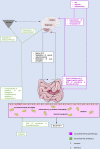Bi-Directionality of the Microbiota-Gut-Brain Axis in Patients With Functional Dyspepsia: Relevance of Psychotherapy and Probiotics
- PMID: 35295092
- PMCID: PMC8919856
- DOI: 10.3389/fnins.2022.844564
Bi-Directionality of the Microbiota-Gut-Brain Axis in Patients With Functional Dyspepsia: Relevance of Psychotherapy and Probiotics
Abstract
Functional dyspepsia is one of the most commonly diagnosed disorders of the gut-brain interaction worldwide. The precise pathogenesis of functional dyspepsia is complex and remains incompletely understood. Therefore, advances in the understanding of functional dyspepsia could change clinical practice. The aim of this review is to highlight the relevance of psychotherapy and probiotics in the context of the microbiota-gut-brain axis in the pathophysiology and especially in the treatment of functional dyspepsia. Therefore, studies which have been conducted to investigate the role of psychotherapy and probiotics in FD and the microbiota-gut-brain axis in the pathophysiology of functional dyspepsia were examined, and the outcomes of this research summarized. There might be a link between changes in the microbiome and functional dyspepsia. Even though, specific alterations in the microbiome that may be pathognomonic in functional dyspepsia remain unclear, the use of probiotics became a viable treatment option for patients with functional dyspepsia. Since mental illness also plays an important role in the pathophysiology of functional dyspepsia, psychotherapy is a useful treatment method, with additional study results indicating that psychotherapy may also shift the microbiome in a favorable direction. Moreover, other findings suggest that probiotics can be used not only to alleviate gastrointestinal symptoms in functional dyspepsia, but also to treat or even prevent mental disorders in these patients. In summary, in this review we highlight the bi-directionality of the microbiota-gut-brain axis in the pathophysiology of functional dyspepsia. Although there are multiple treatment approaches, the burden of disease in patients with functional dyspepsia is still enormous and a definitive therapy to cure this disease does not (yet) exist. Lastly, there is a lack of studies on the impact of dysbiosis, mental health and probiotics on pathophysiology and symptomatology in functional dyspepsia which should be investigated in future studies.
Keywords: functional dyspepsia; gut-brain axis; microbiome; probiotics; psychotherapy.
Copyright © 2022 Rupp and Stengel.
Conflict of interest statement
The authors declare that the research was conducted in the absence of any commercial or financial relationships that could be construed as a potential conflict of interest. The reviewer AM declared a past collaboration with one of the author AS to the handling editor.
Figures
Similar articles
-
Duodenal microbiota dysbiosis in functional dyspepsia and its potential role of the duodenal microbiota in gut-brain axis interaction: a systematic review.Front Microbiol. 2024 Aug 6;15:1409280. doi: 10.3389/fmicb.2024.1409280. eCollection 2024. Front Microbiol. 2024. PMID: 39165566 Free PMC article.
-
Probiotics in Functional Dyspepsia.Microorganisms. 2023 Jan 31;11(2):351. doi: 10.3390/microorganisms11020351. Microorganisms. 2023. PMID: 36838317 Free PMC article. Review.
-
The Role of Gastrointestinal Microbiota in Functional Dyspepsia: A Review.Front Physiol. 2022 Jun 8;13:910568. doi: 10.3389/fphys.2022.910568. eCollection 2022. Front Physiol. 2022. PMID: 35755434 Free PMC article. Review.
-
Current Treatment Options and Therapeutic Insights for Gastrointestinal Dysmotility and Functional Gastrointestinal Disorders.Front Pharmacol. 2022 Jan 25;13:808195. doi: 10.3389/fphar.2022.808195. eCollection 2022. Front Pharmacol. 2022. PMID: 35145413 Free PMC article. Review.
-
Child compound Endothelium corneum attenuates gastrointestinal dysmotility through regulating the homeostasis of brain-gut-microbiota axis in functional dyspepsia rats.J Ethnopharmacol. 2019 Aug 10;240:111953. doi: 10.1016/j.jep.2019.111953. Epub 2019 May 10. J Ethnopharmacol. 2019. PMID: 31082513
Cited by
-
Research trends in the field of the gut-brain interaction: Functional dyspepsia in the spotlight - An integrated bibliometric and science mapping approach.Front Neurosci. 2023 Mar 8;17:1109510. doi: 10.3389/fnins.2023.1109510. eCollection 2023. Front Neurosci. 2023. PMID: 36968499 Free PMC article. Review.
-
From gut to brain: unveiling probiotic effects through a neuroimaging perspective-A systematic review of randomized controlled trials.Front Nutr. 2024 Sep 18;11:1446854. doi: 10.3389/fnut.2024.1446854. eCollection 2024. Front Nutr. 2024. PMID: 39360283 Free PMC article.
-
Weichang' an pill alleviates functional dyspepsia through modulating brain-gut peptides and gut microbiota.J Tradit Chin Med. 2024 Dec;44(6):1177-1186. doi: 10.19852/j.cnki.jtcm.2024.06.006. J Tradit Chin Med. 2024. PMID: 39617703 Free PMC article.
-
Duodenal microbiota dysbiosis in functional dyspepsia and its potential role of the duodenal microbiota in gut-brain axis interaction: a systematic review.Front Microbiol. 2024 Aug 6;15:1409280. doi: 10.3389/fmicb.2024.1409280. eCollection 2024. Front Microbiol. 2024. PMID: 39165566 Free PMC article.
-
Progress in the mechanism of functional dyspepsia: roles of mitochondrial autophagy in duodenal abnormalities.Front Med (Lausanne). 2024 Nov 25;11:1491009. doi: 10.3389/fmed.2024.1491009. eCollection 2024. Front Med (Lausanne). 2024. PMID: 39655235 Free PMC article. Review.
References
-
- Alesci S., Martinez P. E., Kelkar S., Ilias I., Ronsaville D. S., Listwak S. J., et al. (2005). Major depression is associated with significant diurnal elevations in plasma interleukin-6 levels, a shift of its circadian rhythm, and loss of physiological complexity in its secretion: clinical implications. J. Clin. Endocrinol. Metab. 90 2522–2530. 10.1210/jc.2004-1667 - DOI - PubMed
-
- Bailey M. T., Coe C. L. (1999). Maternal separation disrupts the integrity of the intestinal microflora in infant rhesus monkeys. Dev. Psychobiol. 35 146–155. - PubMed
Publication types
LinkOut - more resources
Full Text Sources


